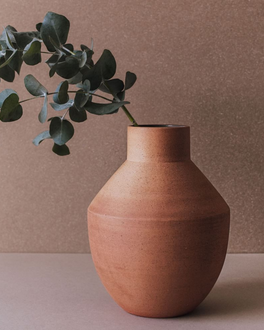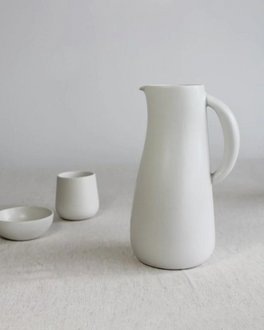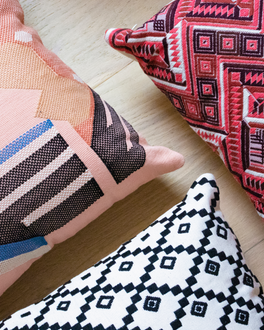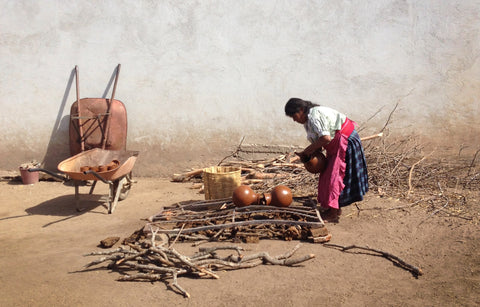
The preparation of the pit fire process in Tlapazola involves the considered stacking of pieces, along with wood, dried organic material and steel.
Pichanchas are colanders for rinsing corn. The shapes are typically rounded with a flat bottom, however some also incorporate handles and tripod feet, which makes them easier to use. Tinajas are large, flat bottomed pots that were traditionally employed for water storage. The clay helps to keep water cool, while also adding an earthy essence. Copaleros are bowls on a tall pedestal or tripod feet that are made for burning incense. These are commonly found in churches, on altars and for cleansing rituals. Comales are wide, rounded clay plates that are set over an open fire to make handmade tortillas, along with other culinary delights.
Aside from the green glazed pieces of Santa María Atzompa, local pottery is mainly unglazed, pit fired and in a range of earthy hues. Finishes are rustic and matte, or perfectly smooth with a subtle sheen. The latter is achieved through intense burnishing with a quartz stone prior to firing. At times, this step requires more time than the initial creation of the piece itself. Pottery from this region is porous and will sweat if holding liquid for long periods. These works will stain if they come into contact with oil and will accumulate marks from utensils. With time and use, a lovely patina will develop that speaks to the lifespan of a piece.
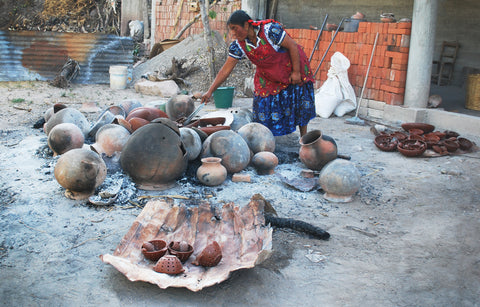
After the pit fire process, barro rojo pottery pieces are left to cool, then carefully removed from the stack.
Local clay varies, however the makers of low fired pottery typically use a mix of sand, clay and water to create their handmade works. This results in an open clay body that absorbs the movement of temperature extremes, making some pieces ideal for cooking – particularly over an open fire, which is still common in this part of Mexico.
Many Oaxacan potters work seated on the ground in a cool, shady room. On the whole, pieces are hand turned and formed using dried corn cobs, strips of leather and other tools. In some communities, like San Marcos Tlapazola, where our colanders and mini salt spoons are made, makers employ an ancient type of wheel that dates back to 1500 BC. It consists of a large stone with a sloped section in the middle that allows for the manual turning of a piece. In Santa María Atzompa, where our blessings beads are made, artisans combine a flat stone that functions as a base for the clay which sits on top of a simple wheel that’s rotated by hand. Other communities don’t bother with a wheel and use coiling, cone forming, slump and drape molding instead.
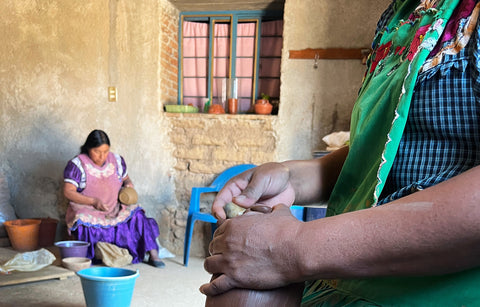
Barro rojo pieces are burnished with quartz stones prior to the pit fire process, in order to encourage a natural sheen.
Once the pieces are formed and dried for an appropriate length of time, they’re pit fired. This process also varies per area. The family in San Antonino Castillo Velasco who create our trenza clay vessels use a brick kiln with a long chimney that pulls smoke upwards, resulting in a healthier process for the makers. In Tlapazola, it involves strategic stacking of pottery, along with layers of wood, dried con stalks and corrugated sheet metal. Artisans in Aztompa employ a rounded kiln made from earth that’s similar to ancient variations found near the ruins of Monte Albán. In San Bartolo Coyotepec, their signature pearly black hue is achieved through reduction firing that’s done in a sealed underground kiln. As these processes involve fire, Oaxacan pottery pieces often features random burn marks on the exterior surface, which are not flaws, but a beautiful reminder of the traditions used in their creation.
The bulk of this pottery is unadorned, however some communities decorate their pieces with plant dyes, pine resin, bark tannins, as well as earth pigments that are applied with brushes and the sharpened ends of turkey feathers. Overall, clay vessels from this region should not be used in the dishwasher or microwave, as this may lead to cracks and degradation. They should also be soaked in room temperature water overnight before first use.

The intense burnishing process in San Bartolo Coyotepec typically requires hours of time and effort.
As with the majority of handmade works in Mexico, contemporary Oaxacan pottery is the result of shared ancestral knowledge. Often, makers note that the skills, techniques and creative processes that they employ stretch back farther than they can remember in their family history. These traditions have remained largely unchanged and so, investment in a custom vessel from this region not only means that you are able to hold a piece of history in your hands, but that you’re also contributing to a market that moves to preserve and encourage these family legacies for generations to come.
